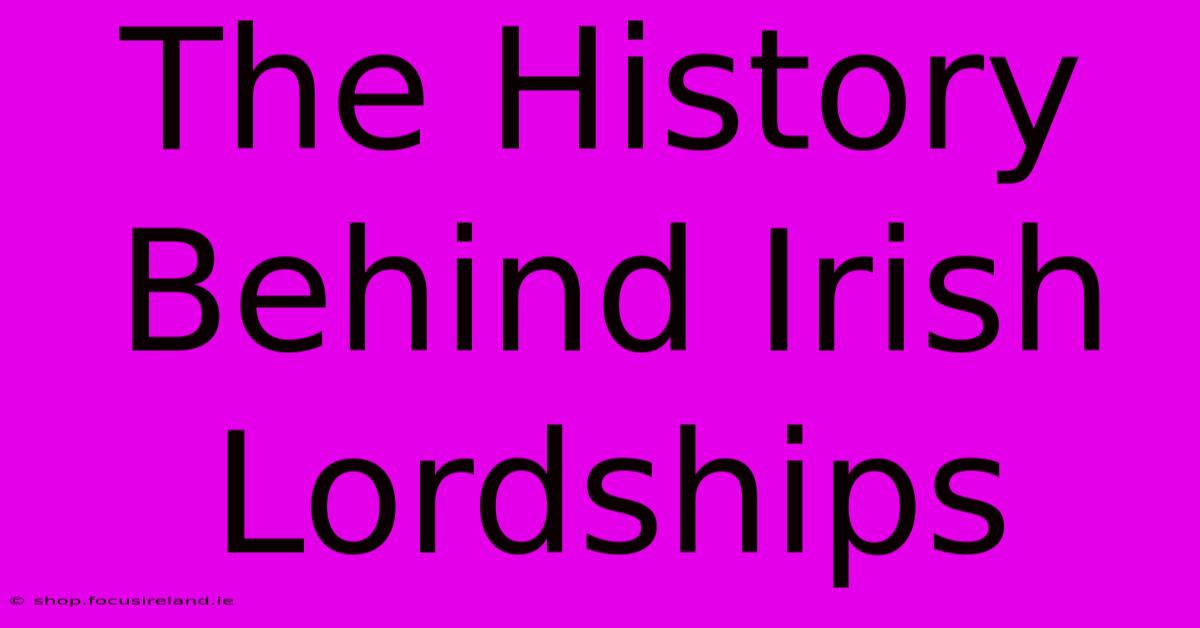The History Behind Irish Lordships

Table of Contents
The History Behind Irish Lordships: A Journey Through Time and Titles
The history of Irish lordships is a fascinating tapestry woven from threads of Gaelic tradition, Norman conquest, and the complex political landscape of Ireland. Understanding the evolution of these titles requires exploring centuries of power struggles, land ownership, and shifting social structures. This journey will delve into the origins, development, and eventual decline of Irish lordships, offering a glimpse into a pivotal chapter of Irish history.
From Gaelic Chiefs to Norman Lords: The Seeds of Change
Before the Norman invasion of 1169, Ireland was a land ruled by a complex system of Gaelic chieftains. These weren't lords in the feudal sense familiar to England, but powerful figures who wielded significant authority over their clans and territories. Their power stemmed from kinship ties, military prowess, and control of resources. These chieftains held sway over their túatha, essentially a tribal territory. The concept of hereditary leadership was strong, but succession wasn't always straightforward, often leading to internal conflicts and power struggles.
The Norman arrival dramatically altered the landscape. Initially, Norman adventurers, lured by promises of land and riches, established themselves as powerful lords, often by forging alliances with or subjugating existing Gaelic chiefs. The resulting power dynamic was incredibly complex. Some Gaelic chiefs adopted Norman customs and titles, merging their traditional authority with the new feudal system. Others fiercely resisted, resulting in protracted conflicts and a hybrid system of governance.
The Impact of English Rule: Consolidation and Conflict
Over the centuries, English rule sought to consolidate control and impose a centralized system mirroring that of England. This involved a systematic attempt to replace the existing Gaelic system with a feudal hierarchy of lordships, mirroring the English model. Royal grants of land, often accompanied by titles like "Lord of X," replaced or attempted to supplant the traditional Gaelic chieftains.
This process, however, was far from smooth. Rebellions frequently erupted, fueled by resistance to English rule and attempts to maintain Gaelic traditions and land ownership. The resulting conflicts, particularly during the Tudor and Stuart periods, profoundly shaped the development of Irish lordships. The land was frequently redistributed, titles were granted and revoked, and the political landscape remained unstable.
The Rise and Fall of Peerages: Irish Titles in the British System
The creation of Irish peerages, titles granted by the British Crown, became a significant part of the system. These were awarded to loyal supporters and often served as a tool to secure political influence and loyalty. The titles, ranging from Baron to Duke, conferred a level of prestige and authority within both British and Irish society, significantly impacting the political and social dynamics of the island. However, many of these titles were viewed with resentment by those who saw them as symbols of English oppression.
The Act of Union and its Aftermath
The Act of Union in 1801 formally united the Kingdoms of Great Britain and Ireland, further impacting the nature of Irish lordships. While Irish peers were allowed to sit in the House of Lords, the integration wasn't seamless. Nationalist sentiment continued to grow throughout the 19th and early 20th centuries, with many viewing the lordships as symbols of a bygone era of British dominance.
The establishment of the Irish Free State in 1922 marked a turning point. The new state inherited many complexities surrounding land ownership and titles but sought to forge a new identity separate from British rule. While titles continued to exist, their significance and power began to wane, reflecting the changing political landscape.
Irish Lordships Today: Legacy and Significance
The legacy of Irish lordships continues to resonate today. Many historical sites and family names reflect the impact of this long and complex history. Understanding the evolution of these titles provides essential context for understanding the social, political, and economic development of Ireland. The struggle for land, power, and identity throughout this period shapes Ireland's identity, even in the modern era. The historical complexities and lasting effects of the system continue to be studied and debated by historians, reflecting the ongoing importance of understanding this pivotal chapter in Irish history. The stories of these lordships, both those who held their titles by right of conquest and those who inherited them through a long lineage, contribute to a richer understanding of Ireland's past and present.

Thank you for visiting our website wich cover about The History Behind Irish Lordships. We hope the information provided has been useful to you. Feel free to contact us if you have any questions or need further assistance. See you next time and dont miss to bookmark.
Featured Posts
-
Avoid These Mistakes Northern Ireland Vs Luxembourg
Apr 12, 2025
-
Luxury Living In Waterford Find Your Perfect Property
Apr 12, 2025
-
Efficient Travel Ireland Time Zone For California
Apr 12, 2025
-
Concra Woods Impress Your Friends With This Round
Apr 12, 2025
-
Bantry B And B Your Gateway To West Cork
Apr 12, 2025
